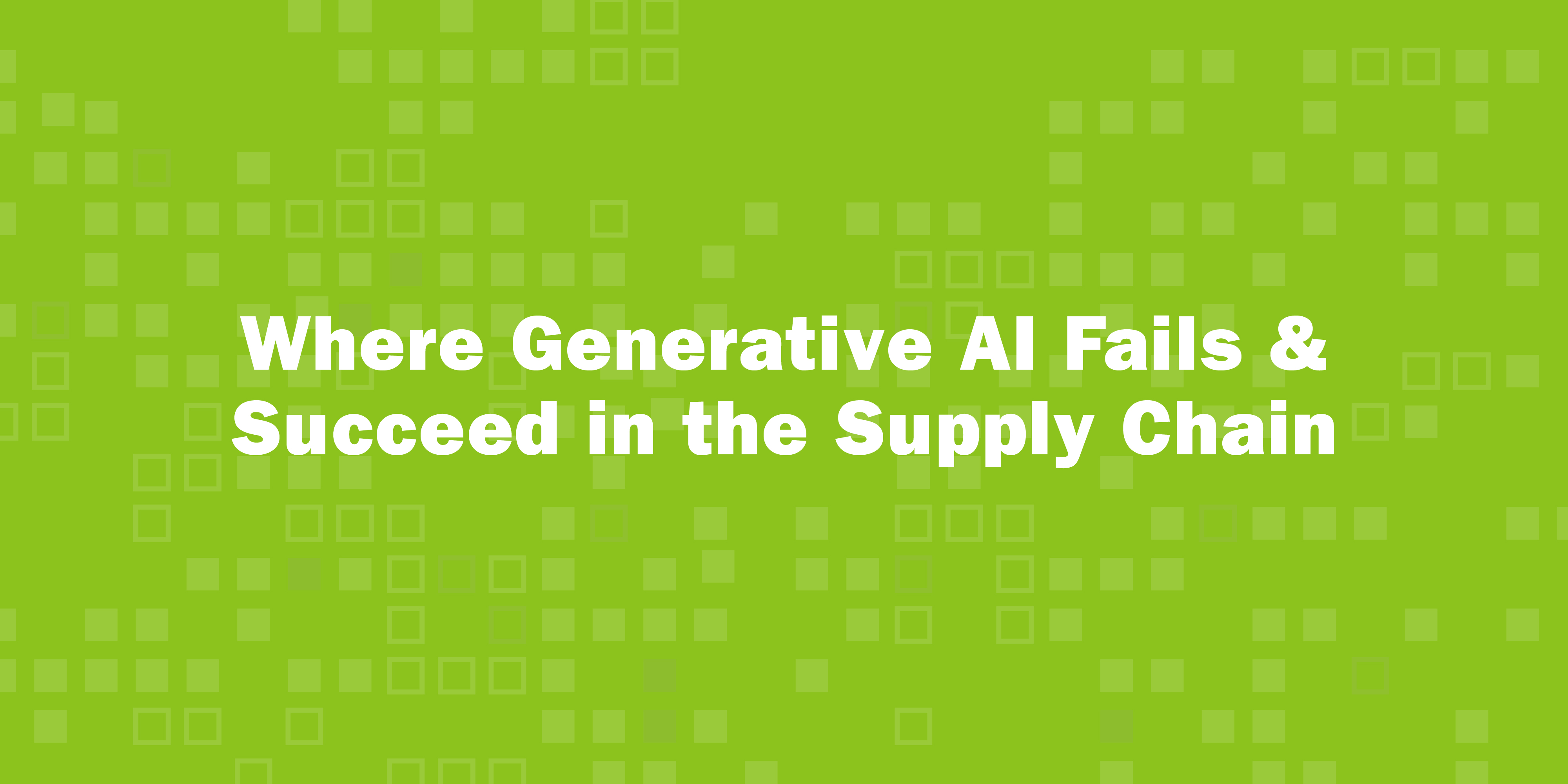Where Generative AI Fails & Succeed in the Supply Chain
Most "AI" used today is often considered "Narrow AI," or analytics that focus on solving problems faster and more accurately than people can. For example, when you buy a product online, there's an algorithm under the hood that looks at your history, compares it to all the data a company like Amazon has, and then recommends other products you might want.
Narrow AI's sole job is to upsell you on other items. It performs a single function that could probably also be done by a person with enough time and experience but nearly instantaneously to improve your likelihood of spending more.
AI today generally fits into a few business "categories":
- Sense & Respond – What happened?
- Predict – What is going to happen?
- Act – What should we do about it?
Shockingly, Generative AI only disrupts one of these areas: Sense & Respond. The reason why is simple – GenAI models like ChatGPT meet us at "our level" and communicate much more effectively.
Google has conditioned us to think of our problems in keyword search terms and often struggles to understand the context behind why we're searching. Often, this means that we spend hours pouring over Google search results because we didn't ask a specific-enough question or are unsure how to analyze the information Google presents to us. Generative AI and GPT models excel when we aren't sure what we're asking because we don't know the industry-specific terms.
Supply Chain Problems Better Solved by Other Analytics
In predictive analytics supply chain planners predict what is going to happen. Given supply chain volatility, big shippers like Procter & Gamble now want to understand the likelihood of different sales projections given data like customer demand coupled with macroeconomic viewpoints. Instead of just creating single-number demand forecasts, companies want to identify the range outcomes that may occur and assign probabilities to each for supply chain teams to war game around.
- Why GenAI Fails: This is not an application for GenAI like ChatGPT because generative tools still struggle with things like numbers. Prediction models are often trained on a very specific data set, meaning there just isn’t enough data to train complex generative models that need millions/billions of to be effective.
In prescriptive analytics, planners determine what should be done about the issue or challenge being analyzed. As our team has done with AutoScheduler.AI in warehousing, every site wants to look at all inbound, outbound, inventory, labor, and equipment data to make decisions about how they manage work over the next 24-48 hours. They then want to automate these decisions into a Warehouse Management, Warehouse Control, and Yard Management systems so that less human-touch is required for flow optimization.
- Why GenAI Fails: GenAI is not a good fit for this at all due to the unreliable expected outcomes, and inability to consolidate many unique data types (text, numbers, constraints, and actions) into a single outcome. Once again, these are data-poor problems, and reliability is paramount. Can you imagine explaining to Walmart that their shipment didn’t go out on time because your AI was pre-seeded by a disgruntled employee to think about Target first? To solve the “Act” problem today, technologies like machine learning paired with more traditional optimization techniques are able to maximize desired outcomes in all logistics operations by modeling constraints & trade offs.
How ChatGPT Saved My Dog’s Life
One evening, my dog was acting oddly, and I needed to figure out if it was an emergency. I needed proof before heading to an emergency vet in the middle of the night. I began googling his symptoms and for each search, I had to analyze multiple links, figure out what was relevant, restate my questions in terms that were already available on the internet, and then re-query. This was so unlike how I would solve this problem with a real veterinarian, but up until very recently this was the best way of distilling the collective knowledge of mankind into digestible results. In the end, I got frustrated because it wasn’t solving MY problem.
That’s what well-trained generative AI models like ChatGPT can do effectively. ChatGPT can interact with me to understand the intent of what I’m asking, remember the context of why I’m asking, and help me decide more quickly. I had a brief dialogue with ChatGPT about my dog, which ended with the phrase:
“It is very important to get your dog to a veterinarian immediately. If it's after hours, try to find an emergency veterinary clinic in your area. These symptoms are serious and should not be ignored. I urge you to seek professional medical help for your Brittany as soon as possible.”
That is an outcome I was able to act on and did. My dog is alive right now thanks to ChatGPT. I was panicked, needed help, and was able to turn to a ChatGPT like assistant to answer my specific questions in a way that I could understand (the diagnosis was a ruptured tumor in my dog’s spleen, which would have been fatal). Interactions like these are what will kill the traditional information consolidation model like Google – the ability to ask anything and get exactly the results you’re looking for, in context, quickly.
This same paradigm for thinking can be used for anything, even in the supply chain. It is possible to have GenAI models interact with you, ask you questions, or even present their answers in unique ways to ensure you understand them. The key to working with GenAI models is to consolidate information & present results but know at the end of the day you are going to be responsible for the outcomes of the decisions you make.
The key limitations around the distillation of information are in your ability to ask questions and constrain results. This is a game changer for everybody, everywhere, forever.



